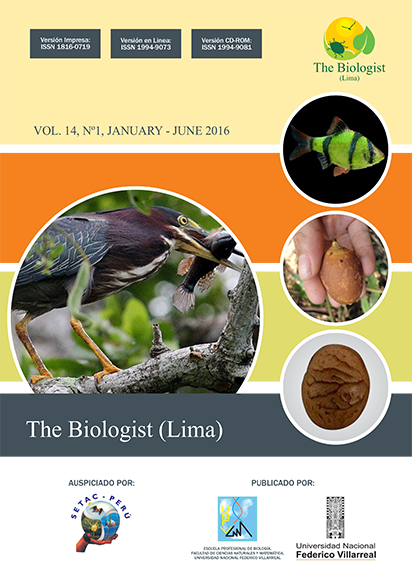FLUCTUACIONES NUMÉRICAS TEMPORALES EN LAS PROPORCIONES ETARIAS Y SEXUALES DE LA TIJERETA DE MAR (FREGATA MAGNIFICENS) (AVES: PELECANIFORMES) EN LA COSTA NORESTE DE LA PENÍNSULA DE ARAYA, ESTADO SUCRE, VENEZUELA
DOI:
https://doi.org/10.24039/rtb201614183Palabras clave:
fluctuaciones numéricas, Fregata magnificens, Península de ArayaResumen
Se evaluaron las fluctuaciones numéricas estacionales, proporciones sexuales y grupos etarios de la Tijereta de Mar (Fregata magnificens) en la costa NE de la península de Araya, estado Sucre, Venezuela, mediante censos con binoculares durante nueve meses, divididos en tres períodos: prereproductivo, desde julio hasta septiembre (PRR); reproductivo, desde octubre hasta diciembre (REP) y postreproductivo, desde enero hasta marzo (POR), ponderándolos a través de estadísticos ANOVA, y valorando tendencias poblacionales mediante Tasas Real de Mortalidad (M) e Intrínseca de Crecimiento (r). La abundancia según los períodos y entre machos y hembras mostró diferencias numéricas pero no significativas. Las diferencias significativas en la proporción de adultos y juveniles (4:1) estaría ratificando el bajo éxito reproductivo de esta especie, a causa, mayoritariamente, de su largo período de incubación (50-60 días) y crianza (150-207 días). La mayor abundancia durante el período PRR probablemente se deba a que no hay movimientos de las tijeretas de mar hacia las áreas de reproducción en las islas de mar afuera, evidenciada luego en su descenso para el período REP, cuando los adultos maduros comienzan a desplazarse hacia el ámbito insular a formar las colonias reproductivas. Durante la mañana la abundancia de individuos fue mayor con respecto a la tarde. La M arrojó un porcentaje de M = 18,09% para el período septiembre 2013-enero 2014. En cambio, para los juveniles machos fue de M = 3,06% y para los juveniles hembras fue de M = 18,13%, estimado desde agosto 2013 hasta marzo 2014. Estos resultados muestran una tendencia moderada a la estabilidad poblacional, sobre todo si tomamos en cuenta que los Fregátidos poseen una estrategia poblacional k, característica de organismos de alta longevidad. La r mostró valores negativos para el segundo período, lo cual pudiera deberse al proceso regular de dispersión de los individuos en búsqueda de otras áreas de alimentación y/o reproducción; para el tercer período se observó un leve incremento de r, que pudiera estar relacionado al retorno de las aves hacia la zona de estudio.
Descargas
Citas
Albarrán, C. & Osorno, J. 2000. The diet of the magnificent frigatebird during chick rearing. Condor, 102: 569-576.
Alves, G.; Coelho, G.; Toscano, M.; Pacheco, G.; Beserra, G.; De Melo, S.; Guimarães, E.; Cabral, M. & De Melo, N. 2008. Ocorrência e sazonalidade do guarapirá Fregata magnificens (Fregatidae) no litoral de Pernambuco, Brasil. Revista Brasileira de Ornitologia, 16: 54-57.
AOU (American Ornithologist Union). 1983. A field guide to the birds of North America. National Geographic Society, Washington, D.C.
Begon M. & Mortimer, M. 1986. Population ecology. 2d. ed. Blackwell Scientific Publications, Oxford.
Branco, J.; Alves, H.; Farina, I.; Lombardo, C. & Hilesheim, J. 2007. Alimentação natural de Fregata magnificens (Fregatidae, Aves) nas Ilhas. Moleques do Sul, Santa Catarina, Brasil. Revista Brasileira de Ornitologia, 15: 73-79.
Brooke, V. 1994. The kleptoparasitic interactions between great frigatebirds and masked boobies on Henderson Island, South Pacific. Condor, 96: 331- 340.
Burger, A. & Lawrence, A. 2000. Seabirds monitoring techniques. In: Status and conservation of West Indians seabirds. Schreiber, E. & Lee, D (eds.). Society of Caribbean Ornithology, Spec. Ruston. pp. 148-173.
Carmona, R.; Guzmán, J. & Elorduy, J. 1995. Hatching, growth, and mortality of magnificent frigatebird chicks in southern Baja California. Wilson Bulletin, 107: 328-337.
Diamond, A. 1972. Sexual dimorphism in breeding cycles and unequal sex ratio in magnificent frigatebirds. Ibis, 114: 395- 398.
Diamond, A. 1973. Notes on the breeding biology and behavior of the magnificent frigatebird. Condor, 75: 200-209.
Diamond, A. & Schreiber, E. 2002. Magnificent frigatebird (Fregata magnificens). Birds of North America. University of Cornell . Ithaca.http://bna.birds.cornell.edu/bna/s pecies/.
Ellison, A.M. & Farnsworth, J. 1996. Anthropogenic disturbance of Cariabbean mangrove ecosystems: Past impacts, present trends, and future predictions. Biotropica, 28: 549-565.
Furness, R. & Camphuysen, C. 1997. Seabirds as monitors of the marine environment. Journal of Marine Sciences, 54: 726- 737.
Gibbs, H. & Gibbs, J. 1987. Prey robbery by nonbreeding Magnificent Frigatebirds (Fregata magnificens). Wilson Bulletin, 99: 101-104.
Gómez, A. 1996. Causas de la fertilidad marina en el nororiente de Venezuela. Interciencia, 21: 140-146.
González, M. & De la Cueva, H. 2007. Apparent survival of adult magnificent frigatebirds in the breeding colony of isla Isabel, Mexico. Waterbirds, 30: 73-79.
Harrington, B.; Schreiber, W. & Woolfenden, G. 1972. The distribution of male and female magnificent frigatebird, Fregata magnificens, along the gulf coast of Florida. American Birds, 26: 927-931.
Hilty, S. 2003. Birds of Venezuela. Princeton University Press, Princeton.
Klein, M.L.; Humphrey, S.R. & H.E. Percival. 1995. Effects of ecotourism on distribution of waterbirds in a wild refuge. Conservation Biology, 9: 1454- 1465.
Lee, D. & Schreiber, E. 2000. West Indians seabirds: a disappearing natural resource. In: Status and Conservation of West Indians seabirds. Schreiber, E. & Lee. D. (eds.). Society of Caribbean Ornithology, Spec., Ruston. pp. 1-10.
Lindsey, K.; Horwith, B. & Schreiber, A. 2000. Status of the magnificent frigatebird in the West Indies. In: Status and conservation of West Indians seabirds. Schreiber, E. & Lee. D. (eds.). Society of Caribbean Ornithology, Spec., Ruston. pp. 58-64.
López, P.; Hazevoet, C. & Palma, L. 2012. Has the magnificent frigatebird Fregata magnificens in the Cape Verde Islands reached the end of the road. Zoología Caboverdiana, 3: 82-86.
McNeil, R.; Ouellet, H. & Rodríguez, J. 1985. Urgencia de un programa de conservación de los ambientes costeros (lagunas, planicies fangosas, laderas costeras y manglares) del norte de América del Sur. Sociedad Venezolana de Ciencias Naturales, 50: 449-474.
McNeil, R.; Rodríguez, J. & H. Ouellet. 1984. Bird mortality at a power transmission line in northeastern Venezuela. Biology Conservation, 31: 153-165.
Muñoz, J.; Alzola, R.; Marín, G. & Prieto, A. 2008. Composición y tamaño de grupos en el alcatraz (Pelecanus occidentalis) y la tijereta de mar (Fregata magnificens), en la península de Araya. Saber, 20: 59- 66.
Murdoch, W.W. 1994. Population regulation in theory and practice. Ecology, 75: 271- 287.
Nelson, J. 1975. The breeding biology of frigatebirds: a comparative review. Living Bird, 14: 13-155.
Osorno, J. 1999. Offspring desertion in the magnificent frigatebird: are males facing a trade-off between current and future reproduction? Avian Biology, 30: 335- 341.
Parker, J., Byers, E. & Bonaccorso, F. 1987. Aspects of the population biology of Fregata magnificens in Belize. American Birds, 41: 11-19.
Reville, B. 1988. Effects of spacing and synchrony on breeding success in the great frigatebird (Fregata minor). Auk, 105: 252-259.
Rabinovich, J. 1978. Ecología de poblaciones animales. Programa Regional de Desarrollo Científico y Tecnológico, OEA, New York.
Rocha, A. & González, M. 2014. Population geneticstructure of Mexican Magnificent Frigatebirds: an integrative analysis of the influence of reproductive behavior and sex-biased dispersal. Revista Mexicana de Biodiversidad, 85: 532-545.
Sokal, R. & Rohlf, F. 1979. Biometría: Principios y métodos estadísticos en la investigación biológica. Blume Ediciones, Madrid.
Šúr, M . ; Bunbury, N . & Van de Crommenacker, J. 2013. Frigatebirds on Aldabra Atoll: population census, recommended monitoring protocol and sustainable tourism guidelines. Bird Conservation International, 23: 214- 220.
Trefry, S.; Diamond, A.; Spencer, N. & Mallory, M.. 2013. Contaminants in magnificent frigatebird eggs from Barbuda, West Indies. Marine Pollution Bulletin, 75: 317-321.
Trivelpiece, W. & Ferraris, J. 1987. Notes on the behavioural ecology of the magnificent frigatebird Fregata magnificens. Ibis, 129: 168-174.
Van Halewyn, R. & Norton, R. 1984. The status and conservation of Caribbean seabirds. In: Status of the world's seabirds. Croxall, J.; Evans, P. & Schreiber, E. (eds.). ICBP Technical Publication Nº 2, Cambridge, UK. pp. 169-222.
Weimerskirch, H.; Le Corre, M.; Marsac, F.; Barbraud, C.; Tostain, O. & Chastel, O. 2006. Postbreeding movements of frigatebirds tracked with satellite telemetry. Condor, 108: 220-225.
Wunderle, J. 1994. Métodos para contar aves terrestres del Caribe. General Technical Report, Department of Agriculture, Forest Service, Southern Forest Experiment Station, New Orleans.
Publicado
Cómo citar
Número
Sección
Licencia
Derechos de autor 2016 The Biologist

Esta obra está bajo una licencia internacional Creative Commons Atribución-NoComercial-SinDerivadas 4.0.
Objeto: El AUTOR-CEDENTE transfiere de manera TOTAL Y SIN LIMITACIÓN alguna al CESIONARIO (Revista The Biologist (Lima)) los derechos patrimoniales que le corresponden sobre sus obras por el tiempo que establezca la ley internacional. En virtud de lo anterior, se entiende que el CESIONARIO adquiere el derecho de reproducción en todas sus modalidades, incluso para inclusión audiovisual; el derecho de transformación o adaptación, comunicación pública, traducción, distribución y, en general, cualquier tipo de explotación que de las obras se pueda realizar por cualquier medio conocido o por conocer en el territorio nacional o internacional.
Remuneración: La cesión de los derechos patrimoniales de autor que mediante este contrato se hace será a título gratuito.
Condiciones y legitimidad de los derechos: El AUTOR-CEDENTE garantiza que es propietario integral de los derechos de explotación de la(s) obra(s) y en consecuencia garantiza que puede contratar y transferir los derechos aquí cedidos sin ningún tipo de limitación por no tener ningún tipo de gravamen, limitación o disposición. En todo caso, responderá por cualquier reclamo que en materia de derecho de autor se pueda presentar, exonerando de cualquier responsabilidad al CESIONARIO.
Licencia de acceso abierto: El AUTOR-CEDENTE autoriza que manuscrito publicado en la Revista Científica The Biologist (Lima) (versión Impresa ISSN 1816-0719, versión en línea ISSN 1994-9073) permanece disponible para su consulta pública en el sitio web http://revistas.unfv.edu.pe/index.php/rtb/index y en los diferentes sistemas de indexación y bases de datos en las que la revista tiene visibilidad, bajo la licencia Creative Commons, en la modalidad Reconocimiento-No comercial- Sin Trabajos derivados –aprobada en Perú, y por lo tanto son de acceso abierto. De ahí que los autores dan, sin derecho a retribución económica, a la Escuela Profesional de Biología, Facultad de Ciencias Naturales y Matemática de la Universidad Nacional Federico Villarreal (EPB - FCCNM - UNFV), los derechos de autor para la edición y reproducción a través de diferentes medios de difusión.








































